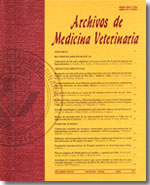Histochemistry and biochemical characteristics of Gluteus medius muscle fibres in draught horses of the equine support plan
Main Article Content
Abstract
Biopsies of the Gluteus medius muscle were taken at 3, 6, and 9 cm of depth in 16 inactive male and female draught horses of the equine support plan, with ages ranging between 5 and 15 years old. The biopsies were analized by the histochemical techniques myosin ATPasa, to determine the fibrilar composition, area and least diameter, and the NADH-TR technique to determine the oxidative capacity of the fibres. Also, the activity of the citrate sintetase (CS), lactate deshidrogenase (LDH) and creatine phosphokinase (CK) enzymes were determined.
The average values in relation with the percentage of each fibre type were 33%, 28%, 17% and 22% for the fibres type I, IIA, IIB oxidative and IIB nonoxidative, respectively. The average area of the fibres was 3959, 4823 and 7087 µm2 and the average minimum diameter was 47, 52 and 59 µm for fibres type I, IIA, IIB respectively. The average of the activity of the enzymes CK, LDH and CS was 0.484, 0.337 and 671 µmol/min/mg protein respectively, showing an increase of the activity of CS with the depth of the biopsy. This increase is related with the percentage of fibres type I. Results obtained show that Chilean mixed draught horses have a high aerobic capacity and relative low anaerobic capacity in the Gluteus medius muscle. These muscle characteristics are consistent with the sort of work carried out by these animals: prolonged and sustained exercise of low intensity.

